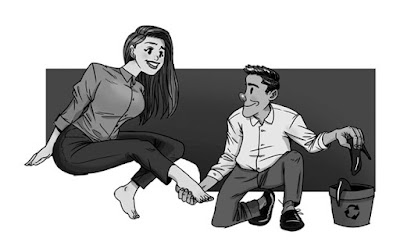Saturday, August 12, 2017
Workers on heels
LAST week, the Associated Labor Unions-Trade Union Congress of the Philippines (ALU-TUCP) did something right for long-term sufferers of pain caused by high heels. It asked the labor department to prohibit employers from requiring employees to wear heels, especially if they spend most of their hours on their feet.
According to news reports by GMA News and Philippine Daily Inquirer, ALU-TUCP was concerned that requiring workers to spend many hours standing in high-heeled shoes would cause them to suffer foot and leg pain, as well as increase the risk of workplace accidents. Now, a lot of us love our high heels. As part of the process of embracing middle age, I now spend most of my workdays in flats or other sensible shoes no more than two inches high.
But I still keep two pairs of three-inch heels for those days when pretending to be 5’8” makes an anxiety-inducing presentation go easier. Up until last year, I took 250 steps every hour, walking down stairs and office corridors, while wearing 3.5-inch wedges. (An admittedly impractical pair that I still have and love.) That continued until one day, SunStar Network Exchange Editor-in-Chief Nini Cabaero pointed out I should probably use safer footwear while chasing my daily step-count goals. (I elected not to say anything recently about her covetable boots.)
ALU-TUCP’s appeal is meant to benefit a different group of workers who, as part of their daily grind, spend long hours on their feet, like salesclerks, promo attendants, waitresses, and hotel receptionists. Apart from the absence of choice, another issue is business expense. When they require high heels as part of their workers’ uniform, how many employers have the good conscience to pay for at least part of the cost of that footwear?
Do they make sure that when employees pay for part of the cost of mandatory high heels through salary deductions, their daily pay does not dip below minimum wage? There are other good reasons to require sensible shoes. Restaurant workers, for instance, may be asked to wear slip-resistant shoes, lest they tumble and accidentally fling a cleaver at one of the chef’s vital organs. Concern for workers’ comfort is another.
A study published in March 2012 by the Journal of Applied Physiology said that long-term use of high heels “may compromise muscle efficiency in walking and is consistent with reports that high heel wearers often experience discomfort and muscle fatigue.” Before they reached that conclusion, researchers Neil Cronin, Rod Barrett and Christopher Carty observed 19 participants, of whom nine had spent at least 40 hours a week, for at least two years, shod in two-inch heels. My argument for prohibiting a high-heel requirement at work has to do with honesty.
Requiring grocery checkout clerks and sales staff to stand in heels for much of their day raises an obvious irony. It is the false elevation of a class of workers whose pay and benefits linger on the lowest rungs of the country’s corporate ladders. Now if a worker chooses to spend the day in heels, then more power to her. (Or him, for that matter.) But there’s a word for employers who require lowly-paid staff to spend their days in impractical and painful shoes: these people are the real heels. By ISOLDE D. AMANTE (On Twitter: @isoldeamante) - SunStar
Read more: http://www.sunstar.com.ph/cebu/opinion/2017/08/13/amante-heels-558140
Follow us: @sunstaronline on Twitter | SunStar Philippines on Facebook
Subscribe to:
Post Comments (Atom)


No comments:
Post a Comment